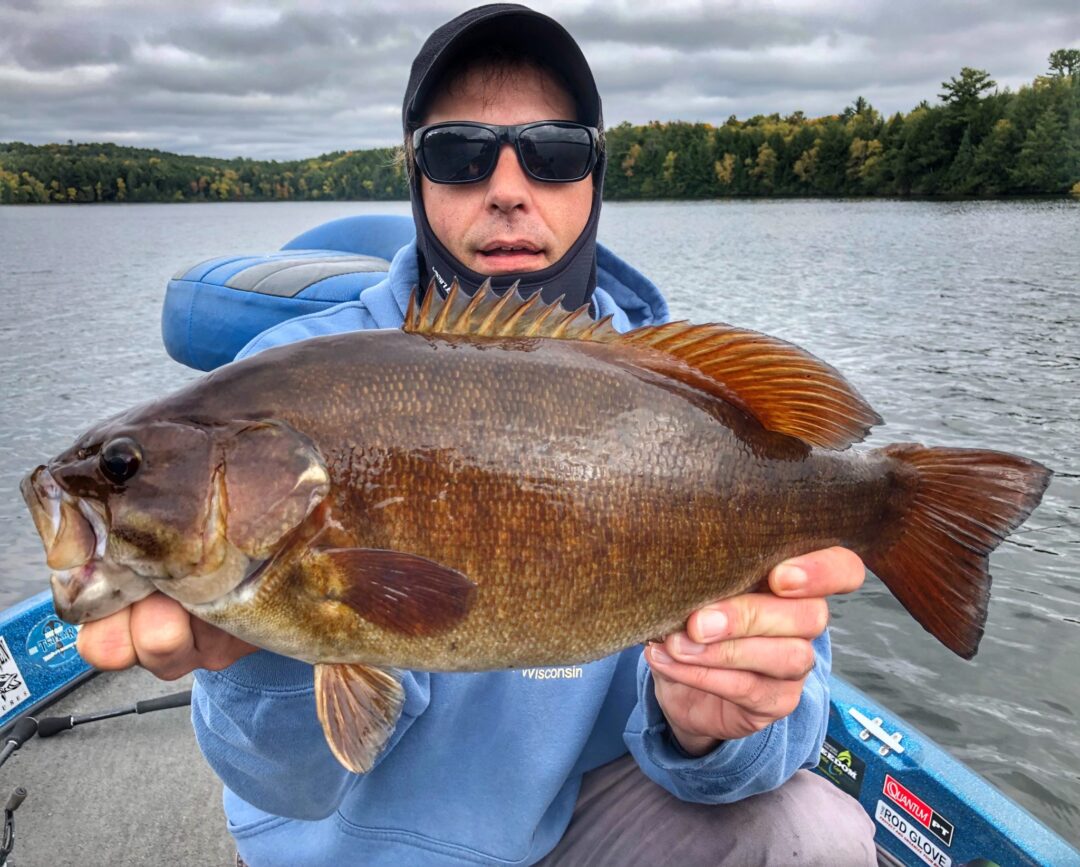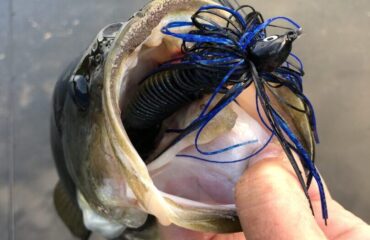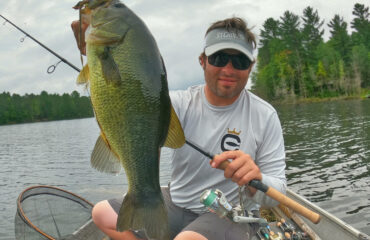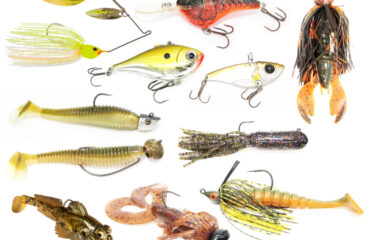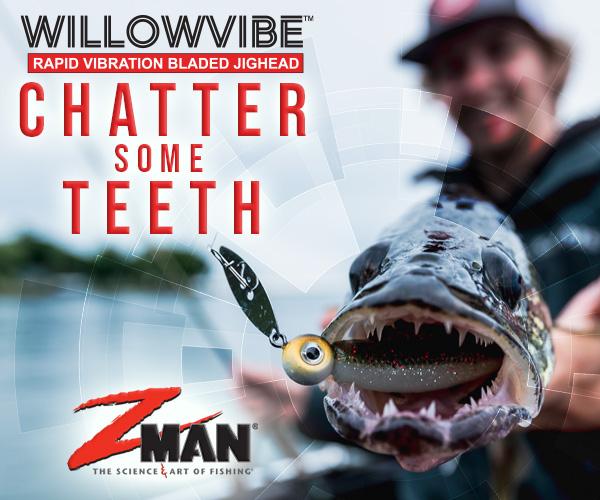Tackling Turnover to Catching Fall Footballs
From September to early November, it’s football season in the north for smallmouth bass.
As the waters cool and lakes cycle through turnover, smallmouth undertake their annual wintering migrations into deep water. Turnover and each of its phases is the focal point of fishing during the autumn season. If fishing strategies and locations aren’t being planned according to the phases of turnover, the pursuit of fall footballs becomes challenging.
The fall fishing season encompasses three sub-seasons that shape fish movements and locations; early fall, mid fall, and late fall. Understand that each stage encompasses different fishing strategies and smallmouth locations. With the entire turnover cycle taking place during autumn’s sub-seasons, it encompasses three phases too, which consists of pre-turnover, turnover, and post-turnover. These three phases will dictate how and where you will fish during the fall season.
Tackling Turnover
Fall turnover is the least understood concept in bass fishing. Understanding each phase of turnover can help dictate how and where to fish for smallmouth on lakes.
Most anglers associate turnover to being short-lasting, at 55 to 57-degree surface temps. However, the cycle begins once summer peak establishes on lakes that stratify, long before the lakes turn over.
By mid-summer when a lake’s thermocline is fully developed, many of the lake’s adult smallmouth have already gradually moved into the deepest, structure-filled reaches of the lake where good oxygen levels and their optimal water temperatures are present. Smallmouth will be deep water creatures for the remainder of the year, where habitat and location is oriented around deep main lake basins.
Smallmouth and their forage species experience predator-prey relationships. Beyond turnover’s influence, fall smallmouth locations also correlate with their preys. During all phases of turnover, baitfish migrations are prevalent and can provide improved feeding windows.
Pre-turnover officially arrives in late summer, lasting through mid-September when cooling weather and water temperatures are the cycle’s main driving forces. Water temperatures that might have been pushing 80 degrees prior to Labor Day have now fallen into the mid 60’s. Late summer and early fall cooldowns further influence smallmouth movements to deep water, but they frequently bring deep dwelling fish back to the shallows where they will temporarily take up residence along flats and rock bars, and deep weed edges of green cabbage and coontail to feed on yellow perch schools. The cooling water temperatures into the lower 70’s and upper 60’s become optimal for big smallmouth to move back into the shallows. Smallmouth will remain feeding in these shallow and mid-depth locations until the lake’s turnover event happens.
September is a transition month. With each cooling day the lake’s water temperatures drop, leads to the thinning of the thermocline. Slowly, the lake’s water clarity dirties. Visibility worsens when turnover begins.
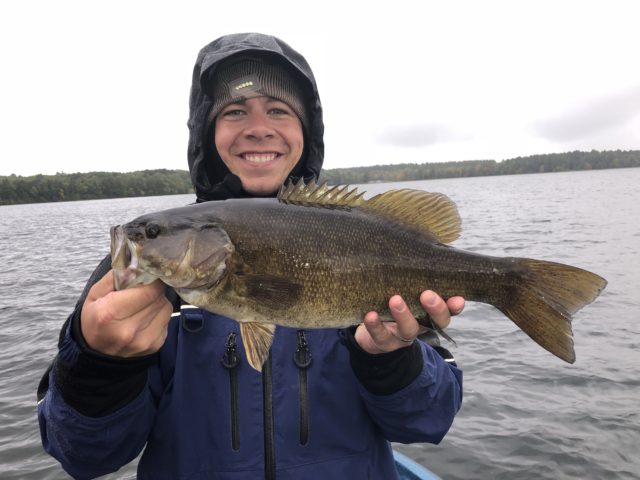
During pre-turnover, casting applications and shallow water fishing are still in play. Guide customer, David Strykowski, holds up a 21 incher from a cold late September trip.
Turnover, the lake mixing stage, officially begins when water temperature is in the low 60’s. Turnover is short, often lasting up to a week before the lake’s visibility clears, but may sometimes be a prolonged process. Cooling weather and water temps, and wind are turnover’s main driving forces. Following its completion, the lake’s visibility becomes clear again.
To avoid the challenges of turnover, always fish ahead of it or behind it.
Post-Turnover encompasses the cold-water pre-wintering period, from the low 50-degree range into the low 40’s. By now the turnover cycle has completed. The entire lake’s smallmouth population has migrated to their over-wintering areas, where they settle at for the next several months.
Cold fronts, snow showers, and northwest winds trigger some of the best fishing and feeding phases of the fall season. The passing of each cold front until winter’s arrival becomes more severe. Bass sense that their growing season is coming to an end.
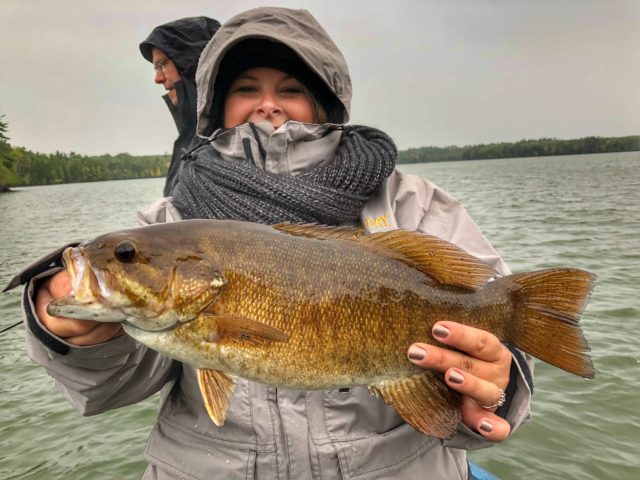
Coldfronts trigger big bites in fall. Valarie Rutledge with a big one during a fall 2018 guide trip.
90% of Smallmouth are in 10% of the Lake
Fall fishing success is usually determined by location rather than presentation. Lake smallmouth are deep structurally oriented fish in fall. By now 90% of the entire lake’s bass population is living in 10% of the lake, in and around wintering locations. The best peak period of autumn occurs after the completion of turnover when fish have moved into wintering areas, making them concentrated, easier to locate and catch.
Smallmouth bass often identify their seasonal locations with pieces of structure. Wintering smallmouth are no different in their habitat preferences than the shallow oriented fish we catch during spring through early summer. Regardless of season, fish are always attracted to the lake’s rocks, boulders, wood, and the unique contours available to them at whatever depths they prefer.
A typical Wisconsin inland lake smallmouth fishery will have upwards of 5 or more main overwintering areas. Wintering holes aren’t specific spots, but pre-determined survival locations that have been identified and utilized by previous generations and current members of the lake’s bass population. The locations are historical to the lake’s bass fishery because they get visited annually by the same community of bass and an individual fish during its entire lifetime. They’re optimal main lake, deep basin and structural sweet spot locations that a community of bass finds and settles on for overwintering protection, survival, and comfort.
Wintering holes are sensitive locations, and smallmouth schools residing near them are vulnerable. They can range in size from as few as 20 fish in small areas, to the hundreds in large areas.
Wintering holes may be centered on a series of deep small humps, rock and gravel to mud transitions, hard bottom rims around deep holes, the deep base of bars and points, and the basins formed by deep secondary breaks. The substrates may consist of deep rock and gravel, bottom transitions, holes, sand grass, and all are commonly in 25 to 30 ft. depths. Wintering areas on some lakes may be in deeper water, greater than 50 ft. Wintering depths all depend on the lake’s maximum depth and how comfortable its bass fishery is in utilizing it.
The greatest challenge for many anglers is their inabilities of locating wintering areas, and poor usage with electronics. Finding wintering areas on a new lake is challenging. Rather than fish, bass anglers could easily be more productive by spending more time idling around several hundred surface acres searching for schools of fish with electronics, and observing the charts and screen.
Years of trial and error, knowing my lake’s bass fishery history, and experience idling around lakes with my Lowrance HDS units has helped me identify and find these wintering bass communities. Identifying deep structure and likely wintering locations with updated Navionics lake charts, and marking schools of smallmouth on side imaging, down imaging, fish reveal, and chirp sonar has enabled me to pursue them deep into the fall season. Our electronics doesn’t lie. Knowing how to interpret fish marks and the lake bottom pays off.
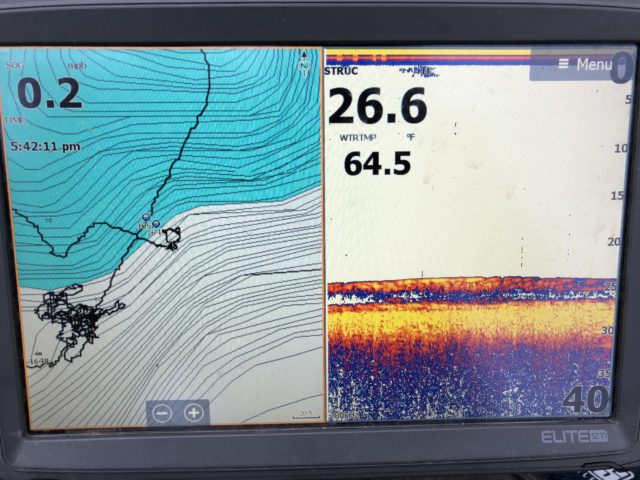
Identifying deep structure and likely wintering locations with updated Navionics lake charts, and marking schools of smallmouth on side imaging, down imaging, fish reveal, and chirp sonar has enabled me to pursue them deep into the fall season. In this shot, a wintering smallmouth is located off the bottom and zoomed in on. This fish was caught moments later on a Damiki Vault blade bait.
Down deep, active smallmouth hover a foot or two off the bottom and appear as wide yellow and orange lines. Fish that suspend are moving and catchable. Multiple fish can appear on screen.
Inactive smallmouth meanwhile will be pegged to the bottom, difficult to see unless fish reveal, and chirp sonar settings are activated. Smallmouth that lay on their bellies are generally inactive, and more difficult to catch.
I won’t bother fishing deep structure at any time of the year unless I mark fish near bottom on chirp sonar and on side imaging zoomed in. But in autumn I will fish these areas regardless, especially if I am visiting a historical wintering area to the lake or have caught bass from the location in past seasons. Often, it is possible to catch fall smallmouth from wintering areas even if your screens were unable to confirm their presence prior to fishing.
If you’ve found some potential wintering sites and fish, drop some waypoints on them and start fishing. Do the same for all other wintering locations you’ve discovered. Throughout the day revisit these same few areas often, as deep wintering smallmouth can turn on at any time.
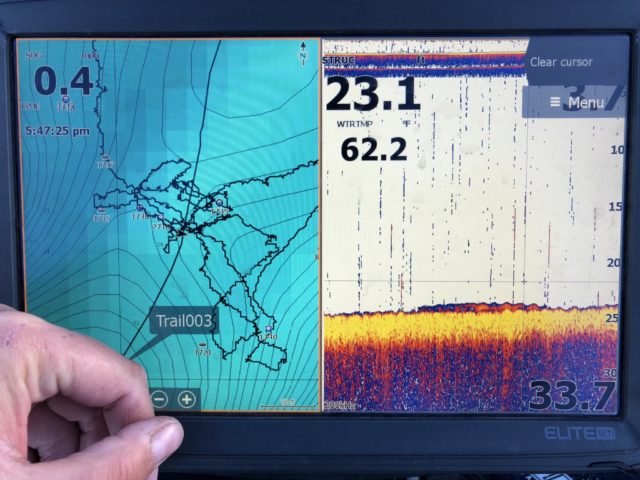
On my screen, you can see the type of wintering area I am focused on; a series of holes and troughs. On the CHIRP panel, an inactive smallmouth has been captured laying on the bottom. Smallmouth that lay on their bellies are generally inactive, and more difficult to catch.
Catching Footballs
The pre-turnover phase is fast and furious fishing. Covering water along flats with search lures and lipless crankbaits, and spot-on-spot fishing high percentage areas with jigs produces best results. Following turnover’s completion, the cold-water period calls for slow and meticulous fishing.
Covering water and fishing many different lakes in a single day is no longer the winning strategy. Camping out on lakes and over smallmouth wintering holes, and patiently waiting for feeding windows to appear and re-appear throughout the midday and afternoon hours enhances success. Midday fishing efforts and sunny afternoons are prioritized during the cold water, post-turnover period in October and early November.
Lake selection should shorten also, because all smallmouth lakes are set-up ideally for post-turnover fishing. Doing so will help you to pattern fisheries and turnover easier. This is the primary reason why I limit myself to fishing only 5 to 10 different lakes in autumn opposed to the dozens I’ll cover in summertime.
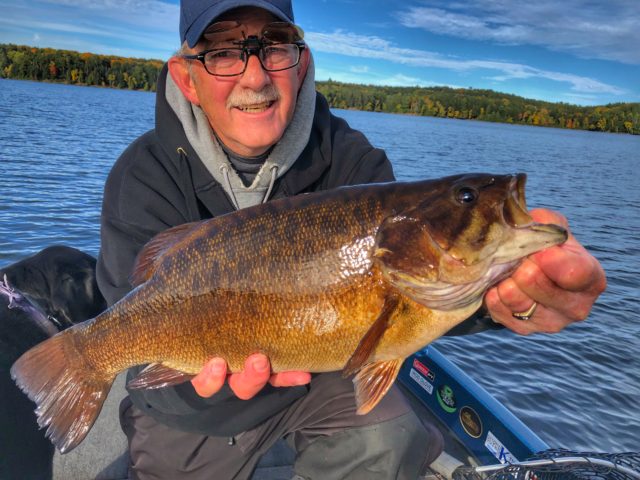
The best odds for midday feeding windows occurs on sunny afternoons. Most of the boat’s biggest smallmouth are captured on October’s sunny afternoons. Partner, Mark Benson, holds his personal best, a 6 pounder from October, 2018.
Fall bites are big fish or bust. Smallmouth are schooling heavily, and vulnerable. Relying on electronics finds them, and position fishing and precision boat control above waypoints with my Minnkota Terrova’s spot lock turned on makes you more efficient. Offshore deep structure jigging, rigging and casting catches smallmouth from depths commonly at 25 to 30 ft. The tackle box closes and fewer presentations will be utilized and needed by the time first ice approaches.
All artificial lures for casting and vertical jigging must dive deep and sink quickly to fish. The artificial assortment should consist of deep diving crankbaits, heavy paddletails, sculpin imitators, tubes and football jigs, fluke minnows, rip baits, and blade baits. Most sizes and weights fished are in the 3/8 oz. to 1 oz. category. For detecting bites, getting them down deep and best hooksets, all baits must be presented on rods with fast action and more bend, and reels spooled up with thin braided superline and fluoro leader, or a fluorocarbon main line.
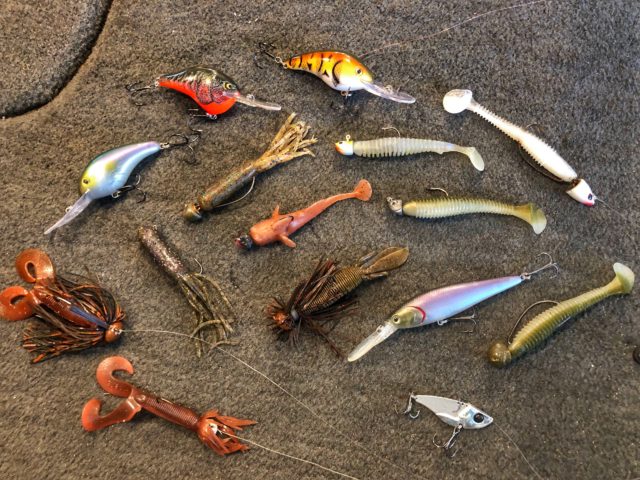
All artificial lures for casting and vertical jigging must dive deep and sink quickly to fish. The artificial assortment for fall smallmouth should consist of deep diving crankbaits, heavy paddletails, sculpin imitators, tubes and football jigs, fluke minnows, rip baits, and blade baits. Most sizes and weights fished are in the 3/8 oz. to 1 oz. category.
Crayfish burrow and overwinter in mud flats and soft bottom that are in proximity to smallmouth wintering sites. A slow and subtle crayfish imitator such as Strike King Coffee Tubes rigged on swinging head jigs, Chompers hula grubs on football heads, and Super-K football jigs dragged through deep water are often successful due to this predator-prey relationship.
Deep diving craw and minnow patterned crankbaits such as a Rapala DT-10 to 20 series models, and Strike King’s 8XD and 10 XD, can be retrieved at several feet deep and trigger the most aggressive strikes.
Cisco and whitefish spawn during November’s full moon when water temperatures are in the low to mid 40’s. Didn’t think trophy smallmouth were catchable late in the year? Slow rolling swimmers such as paddletails and swimbaits rigged on heavy heads produce from daytime staging locations in 20-25 ft. On cisco fisheries, the placement of some smallmouth wintering locations can be within close range to cisco spawning sites. Giant smallmouth are experts at ambushing and feeding on these open water delicacies and will set up nearby for an easy meal during the cisco spawn.
Casting presentations are worthwhile, but vertical jigging can be most effective. Blade baits and rip jigs are winners when smallmouth are catchable from down below. Vertical power jigging a ½ oz. Damiki Vault blade bait, casting and ripping an Acme Lures KastMaster, and rip jigging with Jigging Raps and Acme Hyper-Glides gets the best results and most fish interest until they become conditioned. For best hooking percentage, replace the stock hooks on all baits with size 3 and 2 Trokar TK300 round bend treble hooks.
When fish condition and nothing else works, employing live bait rigs as a last resort can help keep smallmouth interested. We Lindy rig with lively walleye suckers lip hooked with Trokar’s TK-3 wide-load circle hooks, on a 15 to 20” fluorocarbon rig, with 3/8 oz. walking sinker. Keeping a finger on the line at all times to detect bites and immediate line pressure assures smallmouth will be hooked cleanly, and always in the corner of the jaw.
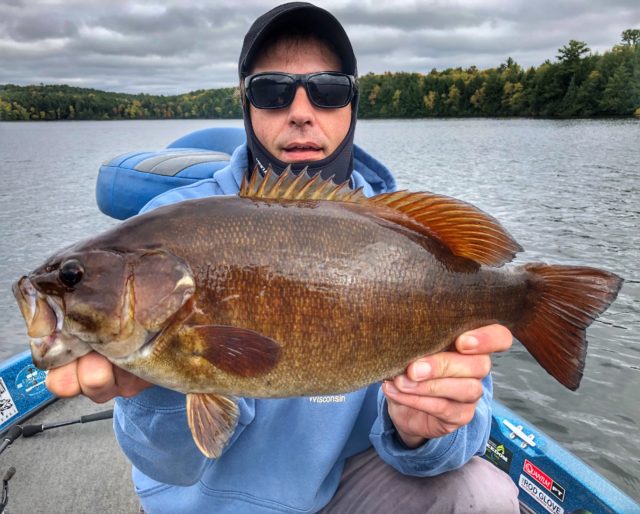
A master at precision live bait rigging, Johnny Amato holds one of his 5 pounders caught in October, 2018.
Fall feeding windows are short and sweet. Catch one and you may quickly follow up with 5 more. Then the bite dissipates, only to return with a flurry of more fish a few hours later.
Schooling smallmouth often lack intelligence during the first 15 to 30 minutes at any wintering hole. The simplest forms of vertical jigging and rigging aided by your electronics will catch the most fish with ease until they condition, slow, or stop biting entirely. When exploited and vulnerable to pressure, wintering bass often move in and out from spots, only to eventually return to them again once they have recovered. Since the typical inland smallmouth lake has multiple wintering areas, jump from spot to spot, and revisit all wintering areas and waypoints to keep catching.
When you hook the big one, play them slowly and methodically up the depths to avoid barotrauma injury. Release the catch immediately, but first let them regain their bearings in the water. Livewell captivity and any displacement from wintering areas in autumn are detrimental to their winter survival. During catch and immediate release smallmouth will always know to swim back to their wintering area down below.
Fall is undoubtedly football season in America. Tackle turnover first, and catch big footballs she throws your way. Let the stages of turnover help you understand and decide where and when to fish smallmouth on lakes in fall.
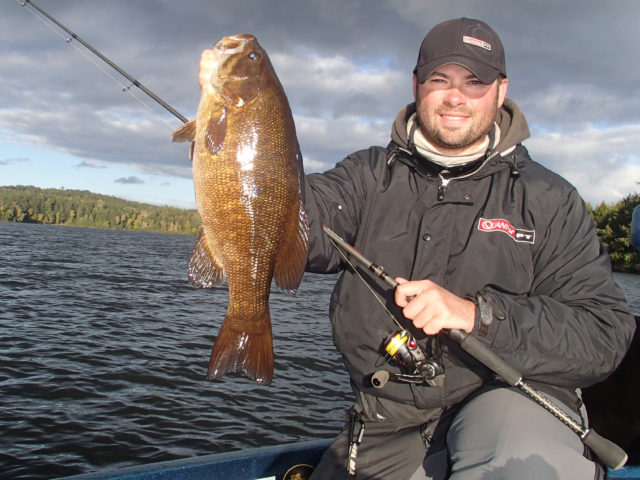
Andrew Ragas splits time between the Chicago area and Wisconsin’s Northwoods. Based in Minocqua, WI, he specializes in trophy bass fishing and offers guided trips from May thru October. While big bass is the passion, he dabbles in multi-species as well. He may be visited online at www.northwoodsbass.com


